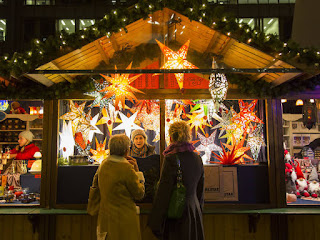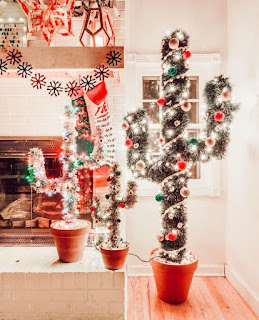
In parts of Louisiana it’s not just Christmas, it’s Cajun Christmas. Cajuns are descendants of French Canadian Catholics who arrived in the area in the late 1700’s. The story of these people, known as Acadians, is (like many other settlers) one of religious and cultural persecution and exile (here is a short history). They settled in the bayous of Louisiana where they could live their own way and their ancestors continue that attitude to this day. Cajuns have their own very unique language, culture and traditions that pull from the ancestral French but are spiced up Cajun-style. And Christmas is no exception - in Cajun Country Santa is called Pere Noel and his reindeer and sleigh transform into alligators and a boat when they reach the bayous (and the alligators have names). Along the levees, bonfires are set on Christmas Eve to help guide him along. These fires also light the way to Midnight Mass. Over the years, people have gotten creative with the size and shapes of these fires – here is a giant alligator being constructed for this year’s Christmas Eve.

In our newest state, Hawaii, Christmas traditions are truly a cultural melting pot. For native Hawaiians, Christmas just happens to fall in the time period of their traditional observance of
Makahiki. This celebratory period between mid-November and late January-early February is meant to be a time to gather and pay tribute to leaders, harvest, rest and recreate. Christmas fits right into that. Many Americans became tuned into Hawaiian Christmas when Bing Crosby first sang “Mele Kalikimaka” (the phonetic version of “Merry Christmas” in native Hawaiian). Modern Hawaii has incorporated cultures from around the Pacific and their Christmas foods show it; sushi is as likely to be on the menu as poi. But, all in all, Christmas in Hawaii looks much like Christmas elsewhere – except that Santa is surfing, or wearing shorts, snowmen are sandmen and poinsettias are what’s blooming on those big trees in the backyard.
 |
| Christkindlmarket , Chicago, IL |
 Here in southern Arizona (and everywhere else there is a large Latino community), Christmas is tamale time. Sure, people decorate their cactus and put out luminarias, but Christmas in Tucson is about the tamales. It’s just in the air. In the last couple weeks, I’ve had numerous random tamale conversations. And people take their tamales seriously. There are unlimited variations to the basic recipe that are endlessly debated, validated, criticized and discussed. In the end, people fall back on what their families have always done. Because those are the best tamales, with that special nostalgic taste that Christmas demands.
Here in southern Arizona (and everywhere else there is a large Latino community), Christmas is tamale time. Sure, people decorate their cactus and put out luminarias, but Christmas in Tucson is about the tamales. It’s just in the air. In the last couple weeks, I’ve had numerous random tamale conversations. And people take their tamales seriously. There are unlimited variations to the basic recipe that are endlessly debated, validated, criticized and discussed. In the end, people fall back on what their families have always done. Because those are the best tamales, with that special nostalgic taste that Christmas demands. |
| Una tamalada |
Why tamales at Christmas? Good question. There are many anecdotal theories (this article has some of those), but there’s no one definitive answer. Tamales have been eaten in the Americas for a very long time and sometimes such ancient sources of traditions can get blurred. What is not in question is that tamales are a family affair. Because they are labor-intensive, the more hands to help, the better. When people gather for the holidays that labor comes right into the kitchen. Tamale making then becomes a bonding experience and a way to honor traditions that is priceless. Here is an excellent article that relates one family’s tamalada. If you don’t have tamale helpers nearby, just like working solo or have never tried making them before, here is an article with illustrated step-by-step instructions. While its title indicates that tamale making is a family event, the clear cut steps will work well for a solo tamale adventure.
 And now I’d like to pivot from specific traditions to straight-up Americana and talk about George Washington. It’s never the wrong time of year to acknowledge the accomplished general and statesman who was our first president, but he also has some interesting connections to Christmas. His famous crossing of the Delaware, for instance. That took place, in the midst of a brutal winter storm, during the night of December 25-26, 1776. This historic moment is reenacted every Christmas in aptly named Washington Crossing, PA. Meanwhile, down at his home in Mount Vernon, Virginia, people come to see his Christmas Camel. Washington was an animal lover and was especially fascinated with creatures from foreign lands. According to historical documentation, he regularly paid to see exotic animals, including a lioness, a tiger, a sea leopard and an an elephant. In 1787, he paid 18 shillings (a considerable amount to pay, about half a laborer’s weekly salary) to have a camel brought to Mt. Vernon at Christmastime. It would have been an extremely rare sight for his family and guests. Modern Mt. Vernon pays tribute to that camel by having a Christmas Camel every year. The current star is named Aladdin and apparently he is happy to pose for selfies, although he has been known to eat the occasional hat.
And now I’d like to pivot from specific traditions to straight-up Americana and talk about George Washington. It’s never the wrong time of year to acknowledge the accomplished general and statesman who was our first president, but he also has some interesting connections to Christmas. His famous crossing of the Delaware, for instance. That took place, in the midst of a brutal winter storm, during the night of December 25-26, 1776. This historic moment is reenacted every Christmas in aptly named Washington Crossing, PA. Meanwhile, down at his home in Mount Vernon, Virginia, people come to see his Christmas Camel. Washington was an animal lover and was especially fascinated with creatures from foreign lands. According to historical documentation, he regularly paid to see exotic animals, including a lioness, a tiger, a sea leopard and an an elephant. In 1787, he paid 18 shillings (a considerable amount to pay, about half a laborer’s weekly salary) to have a camel brought to Mt. Vernon at Christmastime. It would have been an extremely rare sight for his family and guests. Modern Mt. Vernon pays tribute to that camel by having a Christmas Camel every year. The current star is named Aladdin and apparently he is happy to pose for selfies, although he has been known to eat the occasional hat.
There are so many fascinating Christmas celebrations that I simply don’t have the time or space to share them all. I encourage you to look around and find new, delicious, educational and plain old fun ways to enjoy the season in your area.
May the force be with you this holiday season!
Submitted by Pam
 And now I’d like to pivot from specific traditions to straight-up Americana and talk about George Washington. It’s never the wrong time of year to acknowledge the accomplished general and statesman who was our first president, but he also has some interesting connections to Christmas. His famous crossing of the Delaware, for instance. That took place, in the midst of a brutal winter storm, during the night of December 25-26, 1776. This historic moment is reenacted every Christmas in aptly named Washington Crossing, PA. Meanwhile, down at his home in Mount Vernon, Virginia, people come to see his Christmas Camel. Washington was an animal lover and was especially fascinated with creatures from foreign lands. According to historical documentation, he regularly paid to see exotic animals, including a lioness, a tiger, a sea leopard and an an elephant. In 1787, he paid 18 shillings (a considerable amount to pay, about half a laborer’s weekly salary) to have a camel brought to Mt. Vernon at Christmastime. It would have been an extremely rare sight for his family and guests. Modern Mt. Vernon pays tribute to that camel by having a Christmas Camel every year. The current star is named Aladdin and apparently he is happy to pose for selfies, although he has been known to eat the occasional hat.
And now I’d like to pivot from specific traditions to straight-up Americana and talk about George Washington. It’s never the wrong time of year to acknowledge the accomplished general and statesman who was our first president, but he also has some interesting connections to Christmas. His famous crossing of the Delaware, for instance. That took place, in the midst of a brutal winter storm, during the night of December 25-26, 1776. This historic moment is reenacted every Christmas in aptly named Washington Crossing, PA. Meanwhile, down at his home in Mount Vernon, Virginia, people come to see his Christmas Camel. Washington was an animal lover and was especially fascinated with creatures from foreign lands. According to historical documentation, he regularly paid to see exotic animals, including a lioness, a tiger, a sea leopard and an an elephant. In 1787, he paid 18 shillings (a considerable amount to pay, about half a laborer’s weekly salary) to have a camel brought to Mt. Vernon at Christmastime. It would have been an extremely rare sight for his family and guests. Modern Mt. Vernon pays tribute to that camel by having a Christmas Camel every year. The current star is named Aladdin and apparently he is happy to pose for selfies, although he has been known to eat the occasional hat.There are so many fascinating Christmas celebrations that I simply don’t have the time or space to share them all. I encourage you to look around and find new, delicious, educational and plain old fun ways to enjoy the season in your area.
May the force be with you this holiday season!







No comments:
Post a Comment